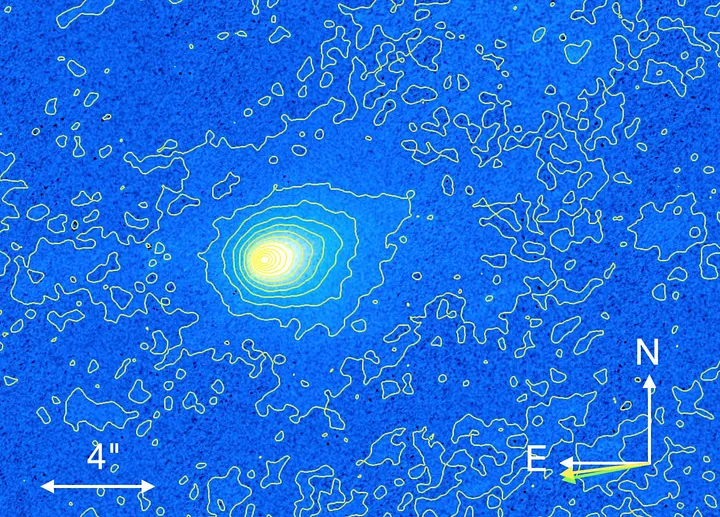Dr. Avi Loeb, a renowned astrophysicist at Harvard University, along with his colleague Eric Keto, published a new analysis of Hubble Space Telescope images of the interstellar object 3I/ATLAS. The study revealed a previously unseen feature: an anti-tail that extends ten times further toward the Sun than previously thought. These new data join other already known anomalies, challenging traditional understanding of comets and natural objects, and opening the door to more exotic interpretations of the object.
The highlight of the research is the brightness of sunlight scattered around 3I/ATLAS, which projects toward the Sun at a distance roughly twice as large as in perpendicular or opposite directions. This asymmetry contradicts the typical behavior of comets, whose tails always point away from the Sun, pushed by solar radiation pressure on dust particles with sizes comparable to the wavelength of light (~0.5 micrometers).
The observation of the anti-tail is even more remarkable due to the geometry of the capture. The line of sight from Earth was misaligned by only 10° from the Sun–object direction on July 21, 2025. Applying the geometric correction factor 1/sin(10°) ≈ 5.76, the researchers concluded that the anti-tail extends roughly ten times more toward the Sun than the lateral or rear width of the tail, an unprecedented phenomenon for any known object.
To explain the scattered sunlight, Loeb and Keto suggest that ice fragments are responsible for the brightness, rather than the refractory dust typical of comets. These fragments gradually evaporate, surviving farther in the Sun-facing direction than laterally or behind, creating a visible and long-lasting anti-tail effect.

Beyond morphology, the optical behavior of 3I/ATLAS is also striking. A new study published this week on the arXiv preprint server revealed that the object exhibits an extremely unusual light polarization, never before observed in comets, asteroids, or any other natural object, either inside or outside the Solar System.
Light polarization provides information about an object’s shape, composition, and surface structure. In general terms, linear polarization indicates that the electric fields of light oscillate in a single direction, while circular polarization involves fields rotating around the propagation axis. For objects like comets and asteroids, polarization patterns give clues about the texture and composition of the particles forming their surface or coma.
In the case of 3I/ATLAS, the results are extraordinary: it displayed a deep negative polarization of -2.77%, observed at a phase angle of just 6.41°, with an extremely low inversion angle of 17.05°. In practical terms, this means the reflected light behaves in a way completely different from any known comet pattern, indicating a previously unseen composition or structure.
During an interview on the program “Question Everything”, Loeb highlighted five main anomalies that make 3I/ATLAS unique among interstellar objects. The first is its retrograde trajectory, aligned with the planetary ecliptic plane with 5° precision—a remarkably rare coincidence with an estimated probability of 1 in 500—causing the object to pass relatively close to Mars, Venus, and Jupiter.
The second anomaly involves the nucleus diameter, estimated with an upper limit of 46 km. If confirmed, this would make 3I/ATLAS about a million times more massive than the interstellar comet 2I/Borisov. The HiRISE camera on the Mars Reconnaissance Orbiter may capture images with 30 km resolution of the nucleus in October, providing even more precise size data.
The third anomaly is the brightness toward the Sun for several months after discovery, forming the anti-tail, behavior never recorded in traditional comets. This feature reinforces the hypothesis that 3I/ATLAS has unique physical properties and ice fragments that survive longer in the Sun-facing direction.
The fourth anomaly involves the object’s gas plume, composed mainly of carbon dioxide (87%), with traces of carbon monoxide (9%) and water (4%), as well as unusual elements such as nickel without iron and cyanide, whose abundance increases as the object approaches the Sun.
The fifth anomaly, which stands out among all, is the previously described extreme negative polarization. Loeb suggests this configuration may be related to the elongated shape of sunlight scattered around the object, with an estimated ratio of 10:1, indicating a geometry or structure not observed in other celestial bodies.
The combination of these five features suggests that 3I/ATLAS does not behave like a typical comet or a conventional interstellar asteroid. Each anomaly challenges current understanding of the physics and chemistry of natural objects in space.

Additionally, a few days ago, 3I/ATLAS showed a change in its coloration. Deep images of the brightness around 3I/ATLAS on September 7, 2025, show a green color. (Credit: M. Jäger and Gerald Rhemann)
In addition to polarization and brightness measurements, the study emphasizes the need for detailed monitoring of the object. Collecting additional data from terrestrial and space telescopes will be crucial, especially when 3I/ATLAS passes close to the Sun, potentially revealing unprecedented information about its composition and internal structure.
Loeb emphasizes that analyzing such objects can provide insights not only about interstellar comets but also about unknown physical and chemical processes, including solar radiation interaction with ice fragments and light scattering on complex surfaces.
In summary, Dr. Avi Loeb and Eric Keto warn that 3I/ATLAS exhibits unprecedented characteristics—its exceptional anti-tail, unusual gaseous composition, and unique light polarization—making it a singular object in the study of interstellar bodies and a case that could redefine traditional astronomy concepts.
Dr. Avi Loeb invoked a well-known biblical quotation from the Book of Ecclesiastes in reference to this new article. He noted that, in the existing scientific literature on 3I/ATLAS, each of these anomalies is generally interpreted within a traditional framework, viewing the object merely as a dusty, water-rich comet. According to Loeb, this reflects the mindset summarized in Ecclesiastes 1:9:
“What has been will be again;
what has been done will be done again;
there is nothing new under the sun.”
The quotation underscores how conventional scientific paradigms can obscure truly unprecedented phenomena, such as those observed in 3I/ATLAS.










